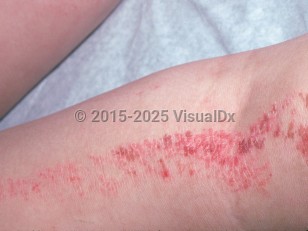Inflammatory linear verrucous epidermal nevus in Adult
See also in: AnogenitalSynopsis

ILVEN typically becomes clinically apparent in early childhood; however, adult-onset variants have been reported. While typically sporadic in occurrence, familial forms have been described. Pruritus is common with ILVEN, and the condition is typically only partially responsive to topical management.
ILVEN was historically classified as a type of epidermal nevus. However, current thinking by many experts is that, rather than being a true epidermal nevus, ILVEN may represent a mosaic inflammatory disorder akin to linear psoriasis and linear lichen planus or a mosaic ichthyosiform disorder. This is theorized because ILVEN has shown response to therapies for psoriasis, such as topical calcipotriene, topical corticosteroids, 308 nm excimer laser, and biologics such as etanercept. ILVEN has been reported in patients who go on to develop widespread psoriasis. Additionally, further investigation has shown aberrant interleukin (IL)-36R / IL-17R pathways in ILVEN, similar to psoriasis and psoriasiform ichthyoses. Further, localized upregulation of IL-1, IL-6, tumor necrosis factor alpha (TNF-α), and intercellular adhesion molecule 1 (ICAM-1) may play a role in its development and perpetuation. About 10% of patients were genetic mosaics for CARD14 in DNA from blood and affected skin.
Some cases of ILVEN have been associated with autoimmune thyroiditis. A rare complication of ILVEN is development of superimposed verruciform xanthomas in adulthood.
Codes
D23.9 – Other benign neoplasm of skin, unspecified
SNOMEDCT:
399995006 – Inflammatory linear verrucous epidermal nevus
Look For
Subscription Required
Diagnostic Pearls
Subscription Required
Differential Diagnosis & Pitfalls

Subscription Required
Best Tests
Subscription Required
Management Pearls
Subscription Required
Therapy
Subscription Required
References
Subscription Required
Last Updated:01/04/2022


